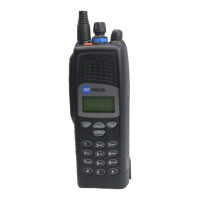TP9100 Service Manual Circuit Descriptions 61
© Tait Electronics Limited May 2005
3.5 CODEC and Audio Circuitry
Introduction For a block diagram of the CODEC and audio circuitry, refer to Figure 3.5.
A/D and D/A
Conversion
The analog-to-digital conversion and digital-to-analog conversion is
performed by the devices IC204 and IC205.
Device IC205 IC205 contains two CODECs. One is used by the FCL. The second is used
for auxiliary audio (input) and VCO modulation (output). The digital
section communicates with this device via a four-wire synchronous serial
interface.
Device IC204 IC204 contains base-band, voice-band and auxiliary CODECs, transmitter
biasing, and some analog signal conditioning. The reference voltage
(nominally 1.2V) for these CODECs is provided internally by IC204 but is
decoupled externally by C217.
Device IC204 (Base-
Band CODEC)
The base-band CODEC handles the I and Q outputs (IRXP, IRXN, QRXP and
QRXN balls) of the receiver’s second IF stage. The analog signals are
differential and biased at 1.2V nominally. The digital section communicates
with this CODEC via a two-wire synchronous serial interface (
BSDO and
BSOFS balls). The digital-to-analog conversion section of the base-band
CODEC is not used.
Device IC204 (Voice-
band CODEC)
The voice-band CODEC handles the microphone and speaker signals.
The digital section communicates with this CODEC via a three-wire
synchronous serial interface (
VSFS, VSDO and VSDI balls). IC204 also contains
voice-band filtering, pre-amplification and volume control.
Device IC204
(Auxiliary CODEC)
The auxiliary CODEC handles transmitter biasing and power control,
receiver tuning and gain control, accessory audio output and general analog
monitoring functions. The digital section communicates with this CODEC
via a three-wire synchronous serial interface (
ASFS, ASDI and ASDO balls).
The DAC used for transmitter bias and receiver gain control (
IDACOUT ball) is
a current output type. Current-to-voltage conversion is performed by
R238. The full-scale output of 1.2V is amplified by IC201 to approximately
3V as required by the receiver and transmitter.
Audio Circuitry The audio circuitry performs four functions:
■ output of audio signal for speaker
■ input of microphone audio signal
■ input of accessory audio signal
■ output of accessory audio signal
The sections of the circuitry concerned with these functions are described
below.

